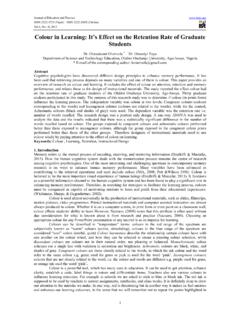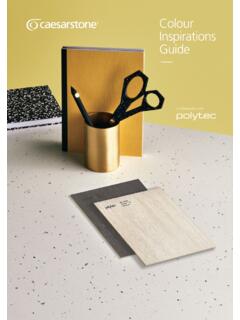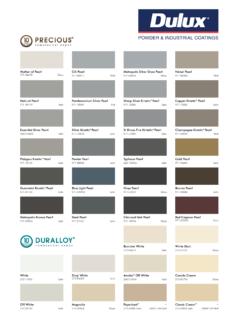Transcription of The Communication Friendly Spaces™ Approach: The …
1 Unit 5D Bethersden Business Centre Bethersden Kent TN26 3JL ELIZABETH JARMAN Foundation | | Office: 01233 Communication Friendly Spaces (CFS ) Approach helps to create positive learning environments for children, young people and adults. This guidance paper is one in a series about the way that colour in the learning environment can impact on behaviour, Communication , emotional well-being and general engagement. Getting the environment right for learners contributes to their overall achievement. The targeted use of colour is one of the most challenging aspects to get right in a learning environment. Over the years, the idea that young children thrive in brightly coloured environments and that a vivid combination of primary colours is the best way to stimulate them and to support their learning has become established in many places for the wide range of research studies into human response to colour has led us to question this.
2 The work that we have carried out with over 26,000 practitioners, teachers and families has prompted us to examine this view more Communication Friendly Spaces Approach: The targeted use of colour in learning environmentsStop and think What colours do we prefer?How many adults would choose the same colours in their living room as those seen in many schools? We re not suggesting that all environments should be totally neutral but when colour is used more thoughtfully, in an informed way, it can enhance learning, influence mood and atmosphere. ?Unit 5D Bethersden Business Centre Bethersden Kent TN26 3JL ELIZABETH JARMAN Foundation | | Office: 01233 , behaviour, well-being and attainmentFrank Mahnke, a researcher working in the USA, found that colour can affect attention spans, creativity, feelings of safety, and comfort levels in a space. Diana Vining, working in Philadelphia in 2006, found experimental evidence that the physical state of a school can affect attendance, instances of violence, and academic Willard R.
3 Daggett and colleagues, found that: colour is an important factor in the physical learning environment and is a major element .. that impacts student achievement, as well as teacher effectiveness and staff Specific colours and patterns directly influence the health, morale, emotions, behavior, and performance of learners. Alison Clark, UK on consulting primary children about colour preferences found that the responses covered a spectrum of colours, with more girls in this small sample suggesting purples and pinks than the boys. Nicholas was aware that he would like the colours to blend with the other furnishings. colour schemes were equally varied for floors. For example, Alex suggested blue green yellow and black. Fernando introduced the subject of patterned flooring, which he apparently had a strong aversion to: I hate patterns. This raises the question of what assumptions are made about designing interiors for young children. Possible spaces P87 Transforming Children s Spaces Children and Adults participation in designing learning environments.
4 Alison Clark Routledge know that colour can affect mood. How often do we use the term to see red when we describe anger? And how often do we see soft blues and greens used to induce feelings of calm in places such as dentists waiting rooms and doctors surgeries? Children s moods too, are affected by the colours that surround them. Sensory rooms or those places in nurseries where young children and babies rest and sleep, are at their best when sensitively decorated in calming : What are the issues and what does the research say?Unit 5D Bethersden Business Centre Bethersden Kent TN26 3JL ELIZABETH JARMAN Foundation | | Office: 01233 colour to planned activities and areasIt s important to think about the whole space, inside and outside, and to decide what you want to happen in them. If the colours are too neutral , they can give an impression of coldness and hardness that could feel unwelcoming or uncomfortable. Look at the New Zealand-based paint company Resen s paper Colours for living and learning , on the impact of colour in a range of spaces on babies, children, young people and HERE to visit their colours for walls, floors, furniture, storage, fabric and equipmentWhen we decorate at home, we tend to choose one main colour and then add accessories in similar tones, or complementary colours.
5 This approach works well in schools, settings and public spaces too. Newcastle University researcher Pam Woolner, found that small and relatively low-cost alterations to the learning environment, such as changing the colour of classroom walls, could make a significant difference to the classroom experience. When colours are chosen from a natural palette they make the space feel open and calm. They also enable the resources and most importantly the people using the space feel more relaxed, at ease and able to concentrate. DisplaysThe use of colour in displays should be more than merely decorative. Children s work is what we want to look at when we see a display. Using a wide variety of backing papers and borders leads to a fight for attention in our brain. When neutral colours are used, we focus on the work and not the backing, as these two examples demonstrate. Stop and thinkAsk yourself and your team: What do we want it to feel like in this area?
6 Use colour to set the scene, encouraging this to take at our website for a before and after DVD about display from Woodpeckers 5D Bethersden Business Centre Bethersden Kent TN26 3JL ELIZABETH JARMAN Foundation | | Office: 01233 t forget outside!Think about how natural light affects inside spaces and how it causes changes that can dramatically alter the effects of colour throughout the day and with the changing of the seasons. Make links between inside and outside spaces wherever possible by using similar tones and shades to merge the two areas together and promote a sense of outside when you are inside. include plants in colourful children s wellingtons outside the play house, bicycle wheels on the fence that have been woven with cheerful splashes of coloured fabric and saucepans tied to the fence for a musical area. The whole setting works well, the links between the inside and outside spaces are harmonious and pleasing.
7 Feedback from children, parents and carers is positive. Case study: Using colour effectivelyGreat Dunham Primary, Norfolk had a new classroom. Staff were torn between choosing a deepish shade of green, a warm blue, or a shade of terracotta that would feel cosy in the colder months. After much deliberation they decided on a shade of blue for feature walls that was happy and warming, but clean and fresh and calming for the children (and staff). Other walls were painted cream. Display boards were a pale cork colour , while the flooring was biscuit coloured with tiny specks of pale silvery blue. Outside areas blend well with inside spaces and Unit 5D Bethersden Business Centre Bethersden Kent TN26 3JL ELIZABETH JARMAN Foundation | | Office: 01233 and special educational needsWe know that people within the autistic spectrum are affected by colour , and that 1 in 12 men have a form of colour blindness. It is also clear that good colour contrast is important for the visually Spectrum Disorder (ASD)There is some evidence that children in the autistic spectrum can become stressed by colour and patterns.
8 There are calming colours and stimulating colours, warm colours and cold colours. The choice of colour in a building can have an impact on behaviour. Research is available on this subject and care should be taken to select and use colour in a way that creates a warm but not over-stimulating Thorne Architects found that for example one wall painted in a golden yellow as a focal Stop and think Approximately 1 in 12 men and 1 in 200 women suffer from some form of defective colour vision. part of the hallway of a special needs school they worked on, was enjoyed by the children coming into the school. Lit by roof lights it created a sunny and warm spot to level of stimulation needs to be controlled because autism is typically marked by extreme sensitivity to the sensory stimulation of sound light and Grandin, whose books describe her own experience with autism, has written that fear including a terror induced by the spatial disorientation that autistics experience in large, busy, unfamiliar environments can overwhelm an autistic person.
9 That fear can cause an autistic child to block out the outside an appropriately colourful environment for children with autistic spectrum Thorne s experience concurs with Magda Mostafa that there is a place for different colour experiences in a child s life that are carefully designed but awareness of the effect is all important. Mostafa advises the following:- Use bright colours to create visual stimulation for the hypo-visual. Use neutral colours to create serenity for the hyper-visual. Use warm colours to create psychological warmth for the hypo-tactile. Defective colour vision Vision itself isn t affected, only the ability to distinguish between certain colours. Understanding how colour blindness affects children is important and needs to be thought through when using colour , for example for the identification of different classrooms. Different shades of red appear dull and , oranges, pale reds and browns all appear as the same hue, distinguished only by their one rare form of colour blindness, blues and yellows can t be distinguished.
10 In another, all colours are seen in black and white. ?Unit 5D Bethersden Business Centre Bethersden Kent TN26 3JL ELIZABETH JARMAN Foundation | | Office: 01233 with colourTips Choose colours from the cool end of the colour wheel. Keep flooring dark and walls light and the floor space will appear to expand. A low ceiling will appear higher if painted a lighter shade than the walls. Use the deepest tone of colour near to the floor and the lightest shade on the ceiling. This will give the illusion of space. Try it the other way around to see how a room can be made to look smaller. A small room doesn t have to be painted in light colours. Emphasise its cosiness by painting it a midnight blue or deep red. To make a room appear cosier, choose colours from the warm side of the colour wheel. A sunny yellow will heat up a room, but don t go overboard, complement it with a white ceiling and woodwork to keep it looking fresh.





